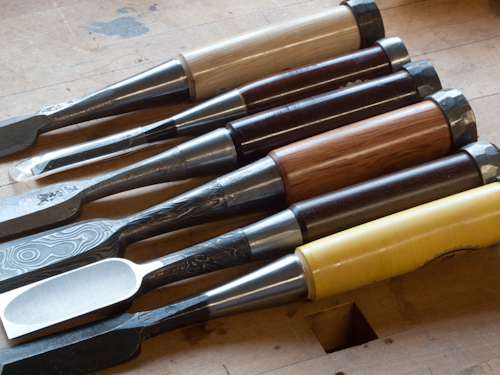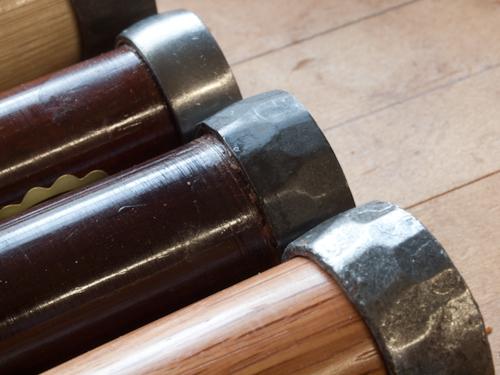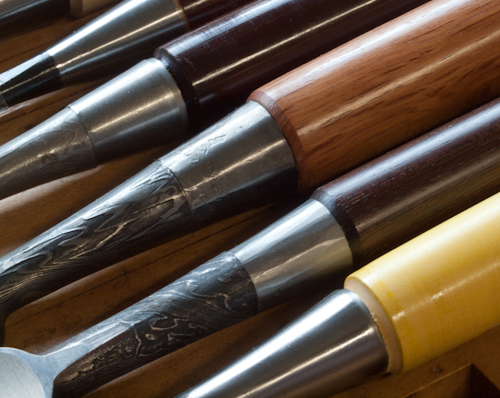|
|
12/18/2013 Decorative Japanese Chisels -Part 2 |
 Last week I wrote about decorative Japanese chisels. Blacksmiths as a group confine most of their decorative work to the blades and the rest of the chisel, no matter the price range, tends to be stock items or nearly so. Last week I wrote about decorative Japanese chisels. Blacksmiths as a group confine most of their decorative work to the blades and the rest of the chisel, no matter the price range, tends to be stock items or nearly so.
Handle making is a specialist trade and none of the modern smiths make their own handles and get them from a couple of suppliers. On even the most expensive tools you can usually see tool marks from the automated turning machines that are used. The only thing that varies is the material. From the top of the lead picture in this entry the woods are: White Oak, Sandalwood, Ebony, Red Oak, Wenge, and Boxwood.
Of these woods Red and White oak are the most common materials found on all Japanese chisels. Oak is resilient and easy to install on a tang, the wood is porous and absorbs sweat, and the material is inexpensive. The other materials listed fall under the category of exotics. All are in general much harder to mushroom without splitting the wood - Ebony being particularly hard and brittle. Installation of a very hard wood handle is harder. Toshio Odate cautioned me many times on the folly of using any other handle material than oak for a handle and certainly in almost all situations he is correct. Even on a paring chisel, which isn't meant to be struck, a non-absorbent handle will be slippier than an absorbent one. The brittle exotic woods are prone to breakage, and cost more money in the first place. But one cannot deny the elegance of the material. My own personal set of dovetail chisels has ebony handles and even with a long soaking mushrooming the handle over the hoop was hard to do, and the mushroom cracked in a couple of places. That being said the handles have a different, "more positive" feel than oak when striking. I feel the material allows a more precise strike with less energy absorbed in the handle. Another major problem with exotics is that Japan is by and large wetter than the US and the handles shrink when they come into the US. With oak you can compress the handle enough so that the hoop will still fit the handle snuggly and all you need to do is mushroom the head. With exotics, which don't compress well, many times the hoops arrive loose and there isn't much that can be done. Nishiki, who made my set, does prefer Ebony over oak for his decorative sets, but I fear it's an aesthetic choice, not a mechanical one.
 The chisels shown are all hooped and designed for striking with a metal hammer. In the old days the blacksmith would forge weld their own hoops. These days, with the possible exception of Tasai, nobody does. The standard hoop is a shiny ring of plated steel, but manufacturers can also purchase stock hammered and blacked hoops for a more handmade look. Tasia's hoops don't look 100% stock, but they probably started out that way. The chisels shown are all hooped and designed for striking with a metal hammer. In the old days the blacksmith would forge weld their own hoops. These days, with the possible exception of Tasai, nobody does. The standard hoop is a shiny ring of plated steel, but manufacturers can also purchase stock hammered and blacked hoops for a more handmade look. Tasia's hoops don't look 100% stock, but they probably started out that way.
The ferrule that joins the chisel body to the handle is also a stock item. After assembly some blacksmiths grind a uniform finish to the top of the chisel bolster and the ferrule so that it looks like one piece, others don't bother, Some blue or blacken the ferrule, and others, like Tasai add forge marks to suggest that the ferrule is made from scratch. In his case they might be but I don't think so.
 Traditionally smiths would sell only the chisels body and leave it to the craftsman to add a handle. These days, especially for American audiences, chisels are sold ready to go. Assembling the chisels, installing the handle, ferrule, and hoop, isn't usually done by the blacksmith. It might be done in their shop, but it is usually done when assembling orders. That way the smith can deliver a wide variety of chisel types with different combinations of handle material, hoop, and ferrule depending on the customer's requirements. It's not at all unusual even in high end chisels to find mismatched ferrules sitting too high on the handle and poorly seated hoops. Traditionally smiths would sell only the chisels body and leave it to the craftsman to add a handle. These days, especially for American audiences, chisels are sold ready to go. Assembling the chisels, installing the handle, ferrule, and hoop, isn't usually done by the blacksmith. It might be done in their shop, but it is usually done when assembling orders. That way the smith can deliver a wide variety of chisel types with different combinations of handle material, hoop, and ferrule depending on the customer's requirements. It's not at all unusual even in high end chisels to find mismatched ferrules sitting too high on the handle and poorly seated hoops.
|
Join the conversation |
|
 Joel's Blog
Joel's Blog Built-It Blog
Built-It Blog Video Roundup
Video Roundup Classes & Events
Classes & Events Work Magazine
Work Magazine



 The chisels shown are all hooped and designed for striking with a metal hammer. In the old days the blacksmith would forge weld their own hoops. These days, with the possible exception of Tasai, nobody does. The standard hoop is a shiny ring of plated steel, but manufacturers can also purchase stock hammered and blacked hoops for a more handmade look. Tasia's hoops don't look 100% stock, but they probably started out that way.
The chisels shown are all hooped and designed for striking with a metal hammer. In the old days the blacksmith would forge weld their own hoops. These days, with the possible exception of Tasai, nobody does. The standard hoop is a shiny ring of plated steel, but manufacturers can also purchase stock hammered and blacked hoops for a more handmade look. Tasia's hoops don't look 100% stock, but they probably started out that way. Traditionally smiths would sell only the chisels body and leave it to the craftsman to add a handle. These days, especially for American audiences, chisels are sold ready to go. Assembling the chisels, installing the handle, ferrule, and hoop, isn't usually done by the blacksmith. It might be done in their shop, but it is usually done when assembling orders. That way the smith can deliver a wide variety of chisel types with different combinations of handle material, hoop, and ferrule depending on the customer's requirements. It's not at all unusual even in high end chisels to find mismatched ferrules sitting too high on the handle and poorly seated hoops.
Traditionally smiths would sell only the chisels body and leave it to the craftsman to add a handle. These days, especially for American audiences, chisels are sold ready to go. Assembling the chisels, installing the handle, ferrule, and hoop, isn't usually done by the blacksmith. It might be done in their shop, but it is usually done when assembling orders. That way the smith can deliver a wide variety of chisel types with different combinations of handle material, hoop, and ferrule depending on the customer's requirements. It's not at all unusual even in high end chisels to find mismatched ferrules sitting too high on the handle and poorly seated hoops.